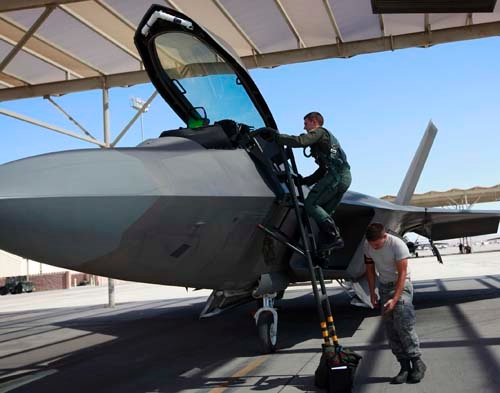F-22 Raptors back in air after grounding
With a mystery still swirling around why some pilots became light-headed while flying F-22 Raptors, the stealth fighter jets from Nellis Air Force Base returned to the skies Wednesday nearly five months after the nation's fleet was grounded.
Air Force officials said they felt confident to lift the stand-down order issued May 3 by Air Combat Command Gen. William Fraser because aircraft inspections and physiological tests determined that planes were safe and pilots were fit to fly.
The stand-down ensured that the F-22s, which cost roughly $400 million apiece, are safe systems, said Col. Robert Garland, commandant of the Air Force Weapons School at Nellis.
"We haven't found a smoking gun, and that's a good thing," he said about an hour after six F-22s took off Wednesday from a Nellis runway.
The school's instructor pilots were among the first to return to flying from the nation's fleet of 170 aircraft. In all, 14 Raptors are assigned to Nellis in the north Las Vegas Valley. They are flown by the 422nd Test and Evaluation Squadron and the 433rd Weapons Squadron.
On Monday, Air Force Chief of Staff Gen. Norton Schwartz announced that the return-to-fly process would start while inspections of the aircraft's life-support system continues.
"We now have enough insight from recent studies and investigations that a return to flight is prudent and appropriate," Schwartz said. "We're managing the risks with our air crews, and we're continuing to study the F-22's oxygen systems and collect data to improve its performance."
Raptor pilots from six bases including Nellis were among those who investigators think were exposed to toxins or conditions in the aircraft's life-support system that reduced oxygen levels in their blood during flight.
"We are still studying that," Garland said.
"We have not found anything we can point at to say these are root causes."
During the stand-down, Nellis pilots kept their skills sharp in flight simulators much like professional baseball players who go to batting cages to improve their swings.
They also brushed up on the capabilities of the air superiority fighter jet, touted as the most advanced in the world, and learned to recognize hypoxia-like symptoms that pilots sometimes experience at high altitudes.
"The symptoms you get are important to recognize, especially when you are in a single seat," Garland said. "Your fingers, your extremities get tingly and you experience a sense of euphoria, and your nose gets a little blue. Your body is being denied the oxygen it requires."
He said physiological tests covered the gamut of culprits including carbon monoxide, a combustion byproduct that robs the body of oxygen if it enters the bloodstream.
Physiological tests were conducted to establish a baseline for each pilot who will be monitored, so that comparisons can be made as they continue to fly.
A safety investigation board that was charged with probing the hypoxia-like symptoms that pilots had experienced is expected to release a report with the Air Force Scientific Advisory Board later this year.
In the meantime, maintenance crews will continue to monitor the F-22 engines' compressors that funnel oxygen to the pilots, unlike older jets, which are equipped with oxygen bottles for the pilots.
Garland reacted Wednesday to comments of Pierre Sprey, an aeronautical engineer and F-22 critic who told the Los Angeles Times that the F-22's oxygen supply problems can be traced to the aircraft's complexity. He reportedly said more oxygen system incidents like the 12 that surfaced in three years lurk on the horizon.
Garland said despite the criticism, he wouldn't fly an F-22 unless he thought it was safe, and he said he believes the Nellis jets are safe.
"I'm not going to step foot into an aircraft unless it is safe and I can operate it, fly it as a man, human being, father and husband," he said. "We're going to continue to do that to provide air superiority."
Garland successfully ejected from an F-22 that crashed while taking off from Nellis on Dec. 20, 2004. The Raptor fleet was grounded for two weeks after the crash.
Investigators later blamed the accident on a power interruption of less than a second that led to a flight-control software glitch. The interruption occurred when the F-22's engines were shut down for maintenance and power to the aircraft was being supplied by an auxiliary ground unit.
Contact reporter Keith Rogers at krogers@reviewjournal.com or 702-383-0308.

















